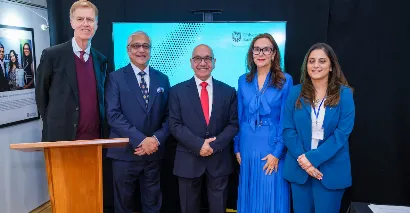Key Highlights
The University of East London (UEL) has become the first institution in the sector to sign a memorandum of understanding (MoU), with the National Indian Students and Alumni Union UK (NISAU UK) to enhance the welfare, employability and belonging of Indian students in the United Kingdom. The strategic agreement, which was declared in the Stratford campus of UEL, contextualizes a supportive framework of the Indian students, in the pre-arrivals phase, during the course, and the post-graduation achievement.
Why This Pact Matters?
This partnership is an important change in the way institutions take care of international students, particularly the Indian students. As one out of 20 Indian students who decide on the UK as their destination is purportedly attracted to UEL, the MoU intends to offer a roadmap of best practice in international student engagement.
That association with NISAU UK, which is an organisation representing Indian students and alumni, means UEL is undertaking a longer-term relationship with its Indian student body. They both intend to not only make the students successful academically but also make them have a sense of belonging when in the UK.
On a bigger scale, the agreement can be directly related to the India-UK Vision 2035, a strategic plan of the two countries that singles out education and skills as one of the foundations of the bilateral partnership.
Also Read: Top Jobs in London with Visa Sponsorship for Indians
What Does the MoU Cover?
The MoU provides a broad strategy:
-
Pre-Arrival Assistance: Before prospective Indian students set foot on UK soil, it involves interacting with the students in a way that they are informed on the academic routes, visas/immigration matters, and cultural adaptation.
-
On-Campus Support and Sense of Belonging: Offering programs that make the Indian students feel that they belong to the university community, peer networks, access to welfare services and culturally sensitive support.
-
Employability and Skills Pathways: Co-designing skills and career paths in partnership with leading recruiters (including Tata Consultancy Services, Infosys, Tech Mahindra and HSBC) to realise maximised graduate employment.
-
Community & Alumni Connections: Using the Indian alumni network, industry advisory boards, and research connections to strengthen the institutional relationships between India and UEL.
Strategic Drivers Behind the Move
There are a number of strategic reasons that seem to have prompted the pact:
-
Increasing Indian Students: UEL is recording a significant percentage of Indian students in the UK being attracted to the institution- this agreement will tap into this group and help them.
-
Healthy Competition in the International Education Environment: The International student market is highly competitive in the UK. Study institutions are being pressured by the need to achieve high standards of student welfare, student outcomes, and student value. The agreement makes UEL an innovator.
-
Connection to Bilateral Relations and Economic Usefulness: Indian students bring a lot of economic usefulness to the UK (according to one estimation, it is 42 billion a year). Student welfare will serve the larger strategic objectives of both countries.
-
Institutional Branding and Differentiation: The creation of a sector-first agreement causes UEL to enhance its brand among Indian students and families by sending a signal of devotion to welfare, belonging and career achievement.
Implications for Indian Students
The advantages of the MoU are significant to the Indian students who are thinking about the UK, or UEL in particular:
-
Greater Support: Since arrival at post-graduation, the students may expect a more organised framework that will assist them in adapting, engaging, and succeeding.
-
Greater Employability: Recruiters associated with large Indian and international companies will be connected to the pathway, which means that the students can benefit in terms of internship and graduate employment opportunities.
-
Enhanced Community Sense: It is probable that there is involvement of NISAU UK as peer networks, alumni participation and culturally informed mechanisms.
-
Benefit to Other Institutions: As UEL is portraying this as a best practice model, the Indian students can be advantageous in general when other universities replace their models.
Nevertheless, students must also not forget about those aspects that are non-UK related, which include visa/immigration regulations, cost of living in the UK and the academic requirements of studying abroad.
Also Read: London Job Losses Surge After Tax Hikes: Retail & Hospitality Hardest Hit
Institutional and Industry Significance
In terms of institutions, this agreement is an institutional one by UEL to strengthen its presence in India, not only in enrolments, but also in research, alumni and business relationships. UEL highlights its long-term and sustained partnerships in India, like research / social impact partnerships like Sugarcrete and Ornate, which have focused on India, such as job creation and healthcare.
To the sector of international higher education, such a move by UEL can serve as a booster: other UK and international institutions can follow suit on implementing comparable integrated welfare-and-employability models on student groups of selected source countries.
To the recruiters and the employers, particularly those who work with Indian talent in the UK and not to mention the rest of the world, the agreement is an indicator that there will be an ecosystem in which students who are Indian can enter with an increased institutional backing, industrial connection and preparedness.
Challenges and Considerations
Though the MoU is an ambitious and promising agreement, it has certain challenges to its implementation and general impact:
-
Sustaining Engagement: A framework cannot be as good as its implementation, so such factors as monitoring, evaluation and resourcing will play a crucial role.
-
Scalability: In case the pact turns into a blueprint, the model should be easily applicable and efficient in various settings and institutions.
-
Manoeuvring the Policy Changes: International student flows are vulnerable to the changes in visa policy, immigration changes, global reputation and geopolitical changes. Student visa and post-study work visa systems in the UK have undergone modifications in recent years.
-
Academic Student Expenditures and Student Well Being: Welfare represents mental health, financial strains, cultural adaptation, discrimination and belonging. Institutions should deal with them in totality.
-
Measuring Success and Outcomes: What will the measures of success be? Satisfaction of students, retention, and employment? Metrics will be important to define and publish.
The Bigger Picture: India-UK Education Linkages
The agreement is consistent with the wider India-UK educational and skills partnership under the India-UK vision 2035 that puts a people-to-people pillar at the forefront with a focus on talent, innovation and mobility.
In the case of India, the outbound student mobility helps in the acquisition of skills, networks and soft power. In the case of the UK, students of Indian origin are a source of both economic and intellectual capital. An agreement of this kind enhances the relationship between education systems, as well as the bilateral relationships.
The transition is also timed to a period when the world is shifting towards digital, hybrid education, more competitive with Australia and Canada and other countries raising their competitive banners, and the necessity of institutions to prove themselves worthwhile to students and families.
Also Read: Europe's Housing Cost Explosion: Critical Guide for Immigrants
Looking Ahead: What to Expect?
What to expect ahead?
-
Roll-Out and Early Tracking: UEL and NISAU UK should begin to roll out the outlined programmes over the next year or two, i.e. workshops before arrival, employability programmes, peer-networks. Feedback and metrics on students will be eye-opening.
-
Institutional Replication: In the event of success, other UK universities and international institutions may also follow in the footsteps of other universities with respect to Indian students and other high outbound markets.
-
Student Centred Experiences: The winning factor will be the way Indian students will feel about the support, not only in formal programmes, but also in the sense of belonging, cultural acclimatisation, personal development and career path.
-
Research and Impact Connections: UEL can grow its India-related research alliances and provide additional engagement, leadership, and social impact opportunities to Indian students and alumni.
-
Policy Coordination: The education-skills aspect of the India-UK relations can provide an additional initiative, scholarships, research collaboration, alumni networks and institutional connections beyond individual university programmes.
Conclusion
A sector-first agreement between the University of East London and NISAU UK to improve the welfare of Indian students is an ambitious and visionary move in the global higher education system. It is indicative of the changing needs of the Indian students, the strategic goals of the institutions working at the international level, and the increased significance of education in the bilateral relations of India and the United Kingdom.
To the Indian students, it will offer them a more organised assistance, better employability opportunities and a sense of belonging in a new academic setting. In the case of institutions, it is an indication of transition to more purpose-oriented, integrated international student engagement models. The implementation will be crucial as the quality of how the framework is translated into practice within students' life conditions, quantifiable results, and effective long-term practice by institutions will estimate its value.
In the event of success, the model may well bring in a new wave of paradigm shift in the way the universities have been interacting with the international student populations, and therefore, welfare and employability become the key components of global education. Contact TerraTern for more information.








